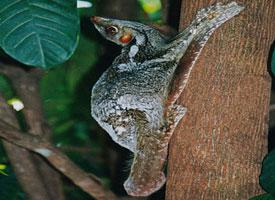
Váhy a míry
| Délka | 40 cm |
|---|---|
| Hmotnost | od 0,9 do 2 kg |
Biologická data
| Délka březosti | 60 d |
|---|
Popis zvířete
The Sunda flying leprechaun, scientifically known as Galeopterus variegatus, is a fascinating creature that belongs to the order Dermoptera. Despite its common name, it is not a lemur and does not truly fly. Instead, this remarkable animal is a gliding mammal indigenous to Southeast Asia, particularly found in the countries of Thailand, Malaysia, Singapore, Indonesia, and parts of the Philippines. Its unique adaptations and lifestyle make it an intriguing subject of study in the animal kingdom.Characterized by its small size, the Sunda flying lemur has a head-to-body length of about 34 to 38 cm and a weight ranging from 0.9 to 1.3 kg. Its most distinctive feature is the patagium, a membrane that stretches from its neck, extending along the limbs to the tips of the fingers, toes, and nails, all the way to the tip of the tail. This thin, furry membrane allows the animal to glide effortlessly through the air for distances of up to 100 meters, though usually, glides are around 30 to 40 meters. The patagium is crucial for its survival, enabling it to escape predators and move between trees in search of food without having to descend to the ground, where it is more vulnerable.
The fur of the Sunda flying lemur is thick and soft, with a coloration that provides excellent camouflage against the bark of trees. It typically displays a combination of gray, brown, and orange hues, with patterns that can include spots and stripes, varying significantly among individuals. This camouflage is vital for avoiding predators, as the animal spends most of its daylight hours sleeping, clinging to tree trunks or nestled in tree forks.
At night, the Sunda flying lemur becomes more active, embarking on its search for food. It is an herbivore, with a diet that primarily consists of young leaves, shoots, flowers, and occasionally fruits. Its sharp teeth are well-adapted for gnawing on tough plant material. Despite its name, the animal does not have a complex stomach for fermenting vegetable matter; instead, it relies on a slow metabolic rate to process its food, allowing it to extract the maximum amount of nutrients.
Socially, the Sunda flying lemur is a solitary creature, with minimal social interaction outside of mating and rearing offspring. Females typically give birth to one offspring, though twins are not unheard of, after a gestation period of about 60 days. The young are born well-developed and cling to the mother's belly, enveloped within the patagium for safety. The mother cares for her young, feeding it with milk and transporting it until it is capable of independent gliding.
Despite its wide distribution, the Sunda flying lemur faces threats from habitat destruction due to logging, agriculture, and urbanization. Although it is currently listed as Least Concern by the IUCN, its population is believed to be declining, and continuous monitoring is necessary to ensure its survival.
In conclusion, the Sunda flying lemur is a unique and fascinating mammal with specialized adaptations that allow it to glide through the forests of Southeast Asia. Its lifestyle, dietary habits, and reproductive behavior reflect a remarkable adaptation to its arboreal habitat, making it an important species for biodiversity and an interesting subject for scientific research and conservation efforts.
Nové fotografie zvířat
Top 10 zvířat
- Common house mosquito (Culex pipiens)
- Common cockchafer (Melolontha melolontha)
- Colossal squid (Mesonychoteuthis hamiltoni)
- Hooded merganser (Lophodytes cucullatus)
- Australian box jelly (Chironex fleckeri)
- Fruit fly (Drosophila melanogaster)
- Common reed warbler (Acrocephalus scirpaceus)
- Elephant hawk moth (Deilephila elpenor)
- Diana monkey (Cercopithecus diana)
- Moustached guenon (Cercopithecus cephus)